2020 Manitou Mezzer Pro
Mounted To: Guerrilla Gravity Smash and Guerrilla Gravity Gnarvana
Test Duration: 4 months
Test Location: Washington
Travel Options (internally adjustable): 140, 150, 160, 170, 180 mm
Wheel Sizes: 27.5” & 29”
Available Offset Options:
- 27.5″: 37 mm & 44 mm
- 29″: 44 mm & 51 mm
Stanchions: 37 mm
Version Tested: 29” wheel; 44 mm offset; set to 150 and 170 mm
Stated Weight (27.5”, 170 mm): 1996 g
Blister’s Measured Weight (29”, 170 mm, uncut steerer tube): 2085 g
MSRP: $1000
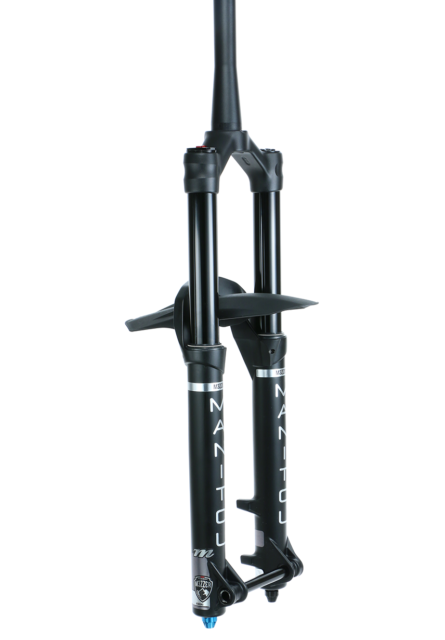
Intro
The long-travel, single-crown category of forks has recently seen a lot of new contenders come to market, with the RockShox ZEB, Fox 38, and EXT Era all being released this year.
But Manitou’s burliest single-crown offering, the Mezzer Pro, was actually released ahead of those three, and at the time, Manitou described it as “the stiffest Enduro fork on the market.”
I’ve been spending a lot of time on the Mezzer Pro, and have been comparing it to its competition in this increasingly crowded category. So how does the Mezzer Pro stack up?
The Design
Off the bat, the most obvious feature of the Mezzer Pro is Manitou’s signature reverse-arch casting, which puts the arch behind the stanchions, rather than in front. Manitou says that this design allows them to design a similarly stiff fork at a lower weight, as compared to a conventional design, and that putting the arch behind the stanchions also helps to protect the seals from dirt and grime thrown up by the front tire. The arch tucks in neatly behind the crown, and shouldn’t pose any clearance issues, even on bikes with particularly chunky downtubes.
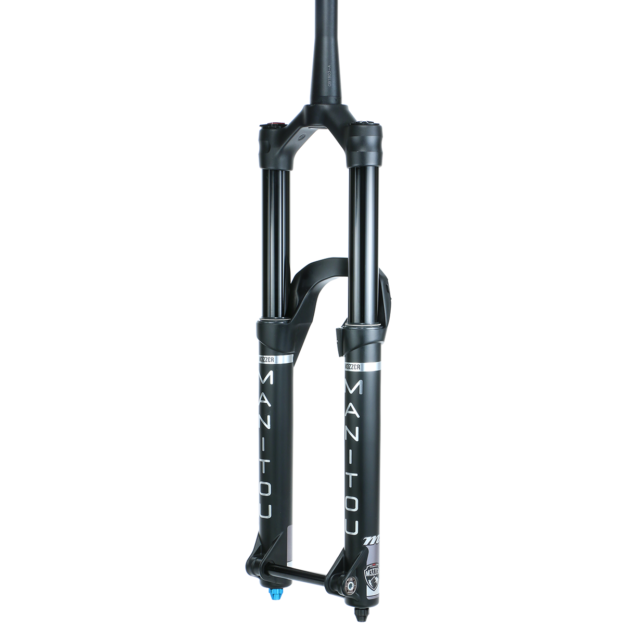
Historically, Manitou’s reverse-arch forks have also featured slightly quirky front brake routing, with the hose routed behind the crown and down the backside of the arch. While it works fine, that setup has always looked a bit strange to me, and I’ve also noticed some extra noise due to cable slap on the backside of the crown on past Manitou forks. Evidently, someone at Manitou agreed with me, because the Mezzer Pro has the option for more standard routing, with a bolt-on plastic guide on the front of the lower-leg casting; adherents to the old Manitou routing scheme also get zip-tie guides for that arrangement on the back of the arch.
Speaking of the arch, the Mezzer Pro has threaded holes for a bolt-on fender, which is included with the fork. I’m glad to see that becoming more commonplace on forks and the Mezzer Pro’s fender works well enough, though the front half of it is a bit too flexible, and occasionally makes some noise as it flops around. It’s not a big deal, but a slightly revised, stiffer V2 fender would be a welcome change.
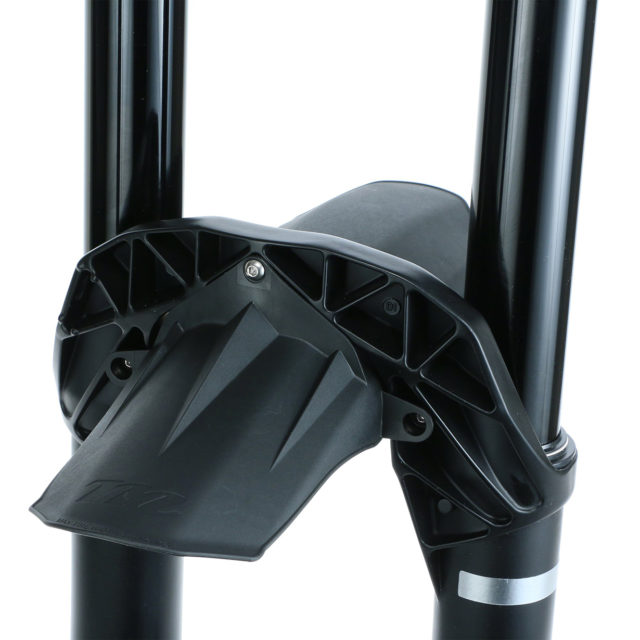
Later Mezzer Pros also feature bleed ports on the backside of the lowers, to relieve air pressure that can build up in the casting; this was a running change introduced in 2020. Unlike those featured on some newer Fox forks (as well as the Fox 40, going back further), the Mezzer Pro’s bleed ports require that the plug be removed with an Allen key, rather than being push buttons. While this makes the process take slightly longer, the advantage is that the ports serve double duty, allowing riders to top-up the lower-leg lubrication oil through the ports, without having to drop the lowers. Manitou’s recommended service intervals call to add 5-7 cc of oil at 25 hours, and to do a full bath oil swap at 50.
Air Spring & “Infinite Rate Tune”
The Mezzer Pro is an air-sprung fork, but its air spring configuration is somewhat unconventional. Like most modern forks, the Mezzer Pro uses automatically equalizing positive and negative air chambers, filled through a single valve. But the Mezzer Pro then adds a second, independently adjusted positive chamber, which Manitou calls Infinite Rate Tune, or IRT for short. The IRT chamber is filled through the top cap, in the location that most forks use for their lone air valve. Then the valve for the positive and negative chambers is at the bottom of the spring-side leg, near the brake caliper.
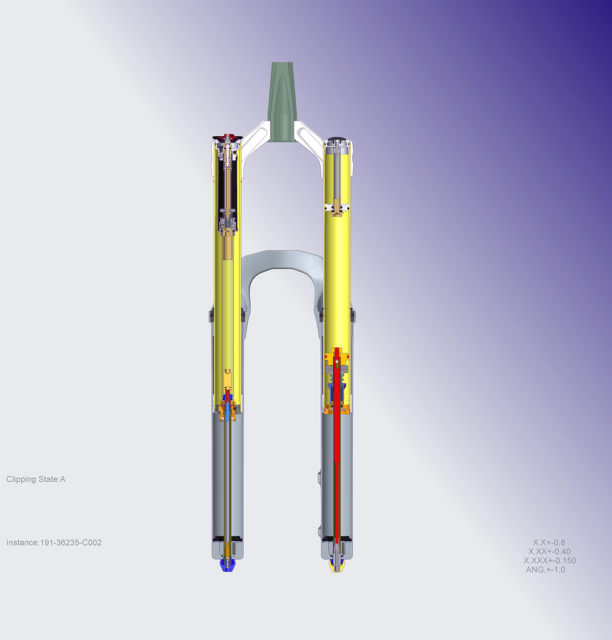
The way the Mezzer Pro’s spring works is fairly straightforward. The “main” positive and negative chambers (I’ll be referring to the three chambers as “main,” “negative,” and “IRT” going forward) work identically to those in most air-sprung forks, but the IRT chamber is effectively a second positive chamber, stacked on top of the main one. A floating piston separates the two, sliding on a shaft that limits how deep the piston can go into the stanchion.
The IRT chamber runs significantly higher pressure (Manitou’s setup guide recommends roughly 30-40 psi more than the main chamber, depending on rider weight and travel configuration), and at the beginning of the fork’s stroke, the pressure in the IRT chamber remains higher than that in the main chamber, and the floating piston consequently doesn’t move. But once the fork compresses deeply enough into its travel, the pressure in the main chamber reaches that of the IRT chamber, and the two begin to compress simultaneously, with the floating piston getting pushed upwards in the fork by the pressure in the main chamber, and consequently compressing the IRT chamber. For a more dynamic, visual explanation, check out this video from Manitou:
Manitou isn’t alone in using a system like this — The Ohlins RXF 36, Ohlins DH38, and the recently released EXT Era use a similar concept for their air-sprung versions. But it is a significant departure from the designs used by the more mainstream brands, notably Fox and RockShox.
There are a couple of ideas behind this 3-chamber arrangement. First, it can make for a more supportive fork that can still readily use full travel. And second, it can do that without as much harshness very deep in the stroke because the pressure in the relatively small main chamber ramps up quickly through the midstroke, without making the fork continue to ramp up as quickly deep in the stroke, since the positive air chamber volume effectively becomes bigger once the IRT chamber comes into play.
It also opens up a variety of possibilities for tuning that aren’t available in a more conventional air-sprung fork, because changing the relative pressure between the main and IRT chambers significantly changes the shape of the spring curve. A greater difference between main and IRT pressure causes the midstroke ramp-up to continue deeper into the travel, and makes the fork overall more progressive and supportive. A smaller difference reduces the midstroke ramp-up, making the fork a bit more supple and sensitive to smaller bumps. I’ll go into more detail below about the on-trail feel and tuning, but the IRT system does work very well.
The Mezzer Pro’s second air valve does mean that setting up the fork is a little bit more involved than more conventional air-sprung forks, and the order of operations is important — the IRT pressure should be set first, and the main chamber second. If the pressure in the main chamber is set first, consequently making it greater than that in the IRT chamber at top-out, the piston separating the two would move upwards, making the main chamber volume bigger and the IRT smaller than intended. Then, if the IRT pressure was set second, the piston would move back down (either part way to its intended position, or perhaps fully, depending on the difference in IRT and main pressure chosen,) inadvertently increasing the main chamber pressure. Doing the IRT first and keeping it greater than the pressure in the main chamber avoids these pitfalls.
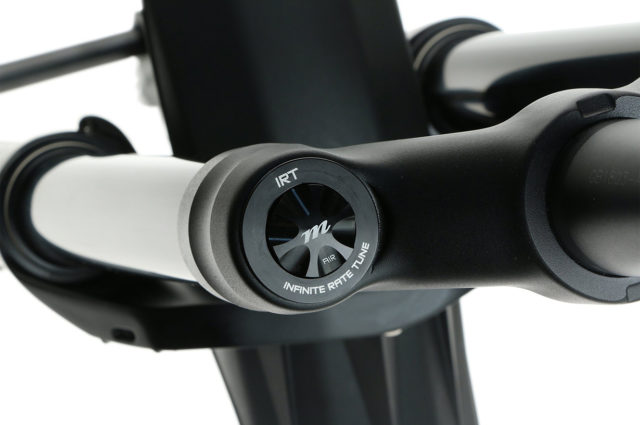
There’s another quirk about setting the main pressure. Most modern forks equalize the pressure between the positive and negative chambers with a small dimple machined into the inside of the stanchion, which allows air to bypass the piston seal at the top-out / fully extended position. This means that the pressure between the positive and negative chambers automatically re-equalizes every time the fork tops out, but also means that there’s a short section of travel (at the top of the stroke) where air can bypass the piston and doesn’t begin to provide any spring force, until that transfer port is closed. I wouldn’t call it a major shortcoming of most air-sprung forks, but it’s one that Manitou wanted to mitigate nonetheless.
To get around the need for a dimple, the Mezzer Pro equalizes the positive and negative chambers when a shock pump is attached to the valve that fills them. This means that there’s no need for a dimple in the stanchion, and no flat spot in the spring curve before the piston moves past that dimple. It also means that, when a shock pump is attached to the fork, the air spring doesn’t provide any spring force, and the fork can very readily sag under its own weight or that of the bike. If you then disconnect the pump in that sagged state, the valve separating the positive and negative chambers closes, and the fork stays stuck down. As such, it’s important to either set air pressure with the bike in a work stand and unweighted, and / or just remember to pull the fork up to full extension when disconnecting the pump. It’s only “hard” to do in that I’m not used to doing it with other forks, and found myself going into autopilot and forgetting at times. Keep this difference in mind, and it’s no big deal.
An upside of its unconventional spring equalization mechanism is that the Mezzer Pro doesn’t require separate air shafts to change its travel. Since the air piston doesn’t need to sit at the same point in the stanchion at topout for the positive / negative chamber equalization to work, the Mezzer Pro simply ships with what is effectively the 180 mm-travel air shaft, along with spacers that can be used to set it at 170, 160, 150, or 140 mm. Doing so does require dropping the lowers off the fork and opening up the air spring, but it’s a straightforward job that anybody with some familiarity working on forks and some basic tools can accomplish in ~30 minutes.
The Mezzer Pro does not use any sort of volume spacers for progression adjustment, instead relying on the IRT system to adjust the spring curve. The IRT spring doesn’t offer a way to separately tune the ramp-up near the end of the stroke in quite the same way as volume spacers do, but I haven’t found myself missing that option in my time on the Mezzer Pro.
MC2 Damper
On the damper side, the Mezzer Pro uses what Manitou calls the MC2, which is a sealed cartridge damper with a bladder for oil volume compensation. The overall architecture is very similar to RockShox’s Charger 2.1 damper or Fox’s RC2 damper from a few years ago.
The MC2 has a single rebound adjuster at the bottom of the leg, and separate high- and low-speed compression adjusters at the top. The MC2 damper also features a hydraulic bottom-out (HBO) circuit, which comes into play in the last 30 mm of stroke, and provides additional compression damping in that portion of the travel. The HBO circuit isn’t externally adjustable, but can be re-valved during a damper service if needed.
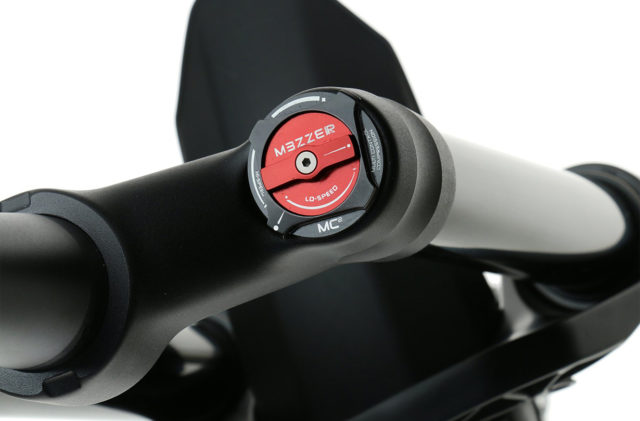
The MC2 damper includes bleed ports at the top and bottom of the cartridge, so that a syringe bleed (similar to how most brake bleed kits work) is possible, making damper service considerably more straightforward than on the older Fox RC2 damper in particular. The Mezzer also has a blowoff valve that allows oil to escape from the cartridge if pressure in the bladder gets too high; bladder-style dampers can sometimes ingest the bath lubrication oil from the lowers, causing them to get overfilled and rupture. Some of the very early RockShox Charger dampers had issues with this, and while RockShox and Fox both dialed in the reliability of their bladder dampers very well in later years, the Mezzer Pro’s blowoff valve seems like a sensible failsafe.
Axle, Brake Mount, & New Versions
Per usual for a modern, single-crown fork, the Mezzer Pro uses a 110×15 mm axle, which attaches via a single, captive bolt in the non-drive-side dropout. Somewhat unusually, the axle is hexagonal where it interfaces with the dropouts, so that it is drawn straight in, since the hex interface means that it’s not able to turn in the fork. The hex axle is meant to prevent the axle from twisting in the lowers, in an effort to further connect them and stiffen the fork.
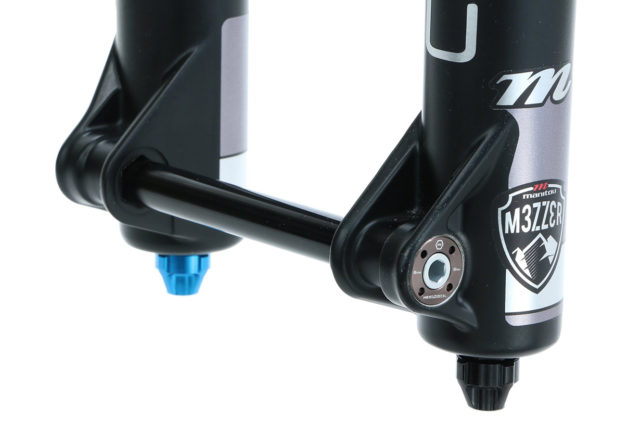
Post-mount brake tabs on the Mezzer Pro are sized for a 180 mm rotor directly, and Manitou says rotors up to 223 mm may be used.
As of publishing this review, the Mezzer Pro is the only version on the market, but a lower-cost Mezzer Expert and a Limited Edition version of the Mezzer Pro will be released this fall.
On The Trail
I’ve run the Mezzer Pro set at both 150 and 170 mm of travel, on a Guerrilla Gravity Smash and Gnarvana, respectively, and it has proven to be an excellent pairing for both.
The most obvious, standout trait of the fork is its midstroke support — the IRT spring arrangement is truly excellent in that regard. Particularly when being pushed hard in steeper terrain, the Mezzer Pro rides notably high in its travel and does a very good job of resisting diving, without needing to be set up to the point that it feels harsh deep in the travel, or can’t use all of its travel.
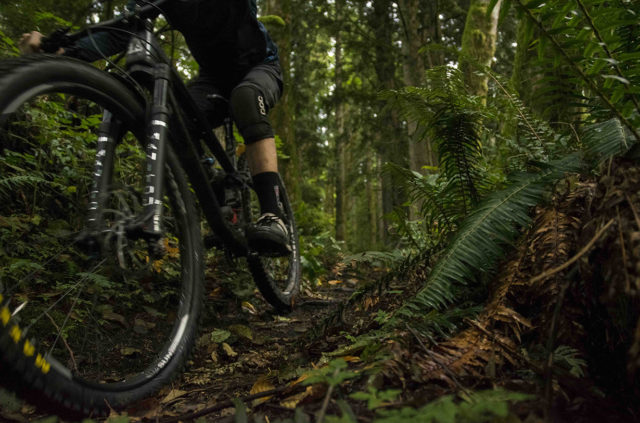
The extra chamber in the air spring does mean that the Mezzer Pro is somewhat more sensitive to pressure changes than more conventional forks, and setup is a little more involved. I started off running Manitou’s recommended pressures for my weight and with the fork at 170 mm of travel — 53 psi in the main chamber, and 80 psi in the IRT. With that setup, the fork felt a bit softer than I’d like, especially earlier in the travel, and my first instinct was to add a couple psi to the main chamber. That did make the beginning stroke a bit firmer, but also felt like it reduced the midstroke support.
While that would seem unusual on a more conventionally air-sprung fork, it actually makes some sense; with a smaller difference between the pressures in the main and IRT chambers, the crossover point where the IRT chamber comes into play would happen earlier in the travel. Therefore, the more aggressive ramp-up in spring rate before the IRT chamber comes into play stopped sooner, and the inflection point where the rate of ramp-up decreased became somewhat noticeable. The result was that, after a certain point midway through the travel, the fork would start to feel dive-y and far less supportive than it had up until that point in the travel.
After that, it was clear that I needed to think about setting up the Mezzer Pro a bit differently than I had become used to with RockShox and Fox forks that use a single air-pressure setting and volume spacers to tune the spring curve. The approach that worked for me is as follows: start with a baseline main-spring pressure that’s roughly at Manitou’s recommended setting, and then experiment with the IRT pressure to find the shape / type of the spring curve that works for you. Varying the difference in pressure between the main and IRT chambers has a dramatic effect on the overall feel of the fork, and some experimentation is going to be needed here. (And to clarify, I’m talking about making these minor changes after already setting your “baseline” pressures in both chambers. When first setting up the fork, you still want to set the pressure in the IRT first, then the main chamber, and then start experimenting)
Manitou’s tuning guide labels their baseline recommendation as “Enduro,” but then they recommend +10 psi in the IRT chamber for “Downhill” use, and -10 psi IRT from baseline for “Trail.”. Once you’ve got a feel for what the IRT chamber does and what kind of difference you want between it and the main chamber, you can then fine-tune how firm or soft (overall) you want the fork to be by changing both chambers in tandem, but keeping the same pressure differential between the two.
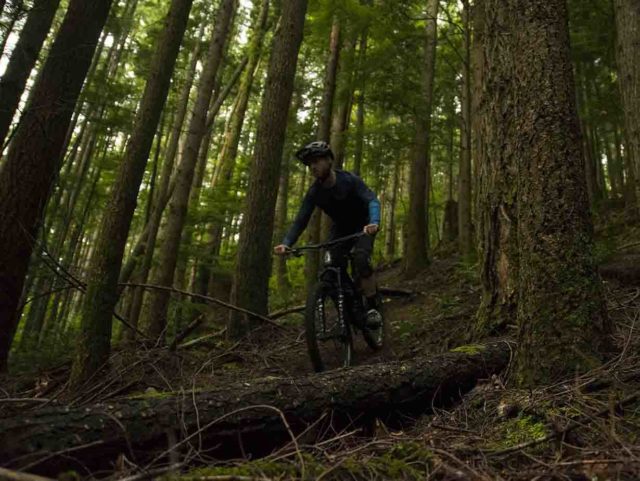
I settled in at 56 psi in the main chamber and 92 psi in the IRT, with the fork at 170 mm of travel, which is nearly Manitou’s “Downhill” recommendation for a 180-lb rider (I weigh about 170 lb). This isn’t terribly surprising, since I often find myself setting up my forks somewhat on the stiffer side of manufacturer-recommended settings, and optimizing for support over small-bump sensitivity. And with that approach in mind, the Mezzer Pro really shines.
With the pressure differential between the main and IRT chambers increased, the Mezzer Pro’s support in steep terrain (when heavily weighting the front of the bike) is outstanding. The sensation of the support falling away deeper in the travel was gone, too. The Mezzer Pro is remarkably composed and predictable when pushing hard.
Of course, it’s easy to get more midstroke support out of any air-sprung fork by simply increasing the air pressure, but doing so comes with tradeoffs when it comes to small-bump sensitivity, and potentially the ability to access full travel. The Mezzer Pro isn’t immune to those sorts of compromises, but especially when running relatively high pressure in the IRT chamber, the amount of midstroke support it offers — without undue harshness elsewhere — truly stands out from the competition (e.g., Fox 36, RockShox Lyrik & ZEB).
The performance of the Mezzer Pro’s damper is commendable as well. Perhaps unsurprisingly, given their similar design, Manitou’s MC2 damper feels quite reminiscent of the Charger 2.1 in RockShox’s recent higher-end, longer-travel forks, which I’ve enjoyed in several different configurations.
Like the Charger 2.1, the Mezzer Pro’s MC2 damper has 5 positions of high-speed compression adjustment. While the overall range of that adjustment is reasonable and each click makes an appreciable difference, I wouldn’t mind having a few more settings in between for better fine-tuning. The Mezzer Pro’s low-speed compression and rebound adjusters each have 11 positions, and both offer a solid, usable tuning range.
The Mezzer Pro’s hydraulic bottom-out circuit seems to work well. I’ve used its full travel somewhat regularly, but never felt an obviously harsh bottom-out. Hand-cycling the damper with it removed from the fork, the effect of the HBO is quite subtle, but of course, it’s a speed-sensitive damper, and getting any substantial shaft speed by hand isn’t really possible.
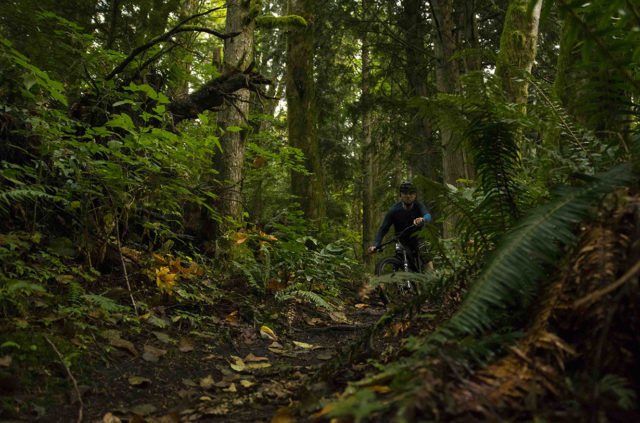
The small-bump sensitivity of the Mezzer Pro is respectable, but not outstanding. Of course, my preferred setup (maximizing midstroke support) does generally come at the expense of small-bump compliance to some extent. Running a smaller difference in pressure between the main and IRT chambers does somewhat improve small-bump sensitivity, trading that off for a loss in midstroke support. The range of tuning available from the spring is impressively large, and while the tradeoff between support deeper in the travel vs. small-bump compliance doesn’t magically evaporate with the Mezzer Pro, it’s possible to achieve an exceptionally supportive setup with somewhat smaller compromises in sensitivity compared to more conventional air-spring designs.
I’ve also been impressed by the chassis of the Mezzer Pro. It’s not quite as stiff (especially torsionally) as the RockShox ZEB, but it’s worth bearing in mind that the ZEB is about 200 g heavier. The Mezzer Pro is closer in weight to the Fox 36 and RockShox Lyrik, and compared to those two, the Mezzer Pro stacks up favorably. The Mezzer Pro is clearly significantly stiffer than the 2015-2020 Fox 36 (I haven’t ridden the updated 2021 version yet). And while I haven’t ridden a Lyrik quite as recently, I think the Mezzer Pro feels a touch stiffer.
Even if it’s not the absolute stiffest single-crown out there, the Mezzer Pro is quite burly for its weight, and is going to be plenty stiff for a whole lot of people. It’s probably accurate to look at the Mezzer Pro as lining up more exactly with the 36 and Lyrik than the 38 and ZEB, but we’re splitting hairs here.
And after 4 months, I haven’t heard any creaking from the Mezzer Pro or noticed any signs of bushing play or similar issues — really nothing to complain about on the durability front. And despite overshooting the recommended service interval for a lower-leg service by a fair bit the first time around, performance hadn’t deteriorated substantially by the time I got around to doing it.
The Bottom Line
The Manitou Mezzer Pro is a well constructed, highly tunable Enduro fork that’s a particularly good option for people looking for a very supportive fork that shines when being pushed hard in steep, technical terrain.
Setting up the Mezzer Pro is a bit more involved when compared to forks with simpler air springs, but that added complexity comes with some very real performance benefits, making a compelling case for riders willing to spend a little extra time with a shock pump to get things dialed. While it’s possible to set it up for a more plush ride as well, the biggest benefits are going to be seen by riders looking for a more firm, supportive ride, and for those people, the Mezzer Pro is outstanding.

Wow. Looks like a sweet piece of tech. I wonder if we’ll start to see some consumer fatigue with setting up suspension with this many variables (specifically the IRT). I just got a new shock and it sure takes a lot of thinking to just get the damping the way I like it.
Astoundingly good review, David. Kudos!
Now that you’re sufficiently buttered up……how would you rate the forks you’ve ridden in terms of small bump compliance? I’ve got a wonky hand, and small bump compliance rules over all else during long days in the woods.
Thanks!
Thanks Tom!
We’ll have the full review of the ZEB Ultimate up soon, where I’ll go into more detail, but if you’re specifically looking to optimize for small bump sensitivity, it’s been very impressive.
Awesome. Looking forward to it.
The Mezzer Pro is hands down the sweetest performing fork out of the box I’ve ever ridden. Though not even available or even needed, things like Luftkappe air piston replacements, Avalanche damper cartridges, the fork straight up works, though as mentioned in the review does indeed require a bit more setup time than the other brands offerings but the end result’s entirely worth it.
I’ve been running this fork on several bikes for over a year now configured anywhere from 170mm Ibis HD5, 160mm Ventana Zeus, 140mm Ibis Mojo4, and as of a couple weeks ago 130mm Ibis Ripley V2. Yep, I reduced it to 130 even though Ibis does give their blessing to bump the Ripley to 140.
On the Ripley, though a bit overkill and 11oz heavier than the Fox Factory Grip2/Lufftkappe equipped fork it replaced, it’s not going anywhere, the added torsional stiffness along with IMO superior damping vs the Fox makes the fantastic handling Ripley even better .
I’ve not tried the Ripley at 140 as I really dig everything this bike does at 130. Even at 130 though the Ripley plays well above its weight class for sure .
Also worth mentioning is I’ve found it a good Idea before riding the fork to pull the lowers to make sure its got the required 21cc of oil bath in the lowers as well as pulling the IRT assy out and making sure the the piston and piston shaft have adequate lubrication as I’ve found that to be sometimes lacking .
As an aside Manitou’s Mara Pro piggy back and Mara Pro inline compliment the Mezzer very well.
Also servicing all the above, if you’re relatively mechanically inclined, is easily accomplished on your home’s workbench.
Oops, the Ripley mentioned above is the V4 not the V2.
Funny.. you guys reviewed both of my suspension products on my bike in the last few days : ext storia v3 and the manitou mezzer (both on a Levo SL – posted my experiences with the ext on the review)
The mezzer has been fantastic. I have an earlier model sans- bleed ports, but qa/qc’D from their earlier issues you may read about on other reviews or some forums.
The adjustability was similar to my lyrik with a DSD runt (equivalent to the IRT) and push hc97; so I had a concept on how to tune it. Funny enough, I found that I went softer on the air spring with a lower ratio between the hi/lo chamber. That’s probably more personal preference than anything , but I find that with the IRT and hbo , I can run a bit softer for the small bump sensitivity and still have great mid stroke and bottom out.
The fork does everything well IMO. It may not be as supple as the aforementioned heavily modified lyrik (180mm) at lower speeds, but at any sort of real trail speed – it’s sublime.
I will agree that the fork is very sensitive to air pressure and takes some time to tune. But it’s definitely worth it. Icing on the cake is I got mine for $800 during a deal on they were having. Crazy value
Mezzer is a fantastic fork. Glad you reviewed it. And… Extremely good detail. Well done.
Thanks I have one of these on order, was starting to get cold feet reading Lyric & Zeb reviews, but this has put my mind at rest:)
Looking back at your experiences with the fork, has anyone (David or other readers) played around with the extremes of the IRT set up? For example, has anyone tried setting up the IRT with a very low, almost matching the main spring, pressure? How did it respond, was the rate linear or digressive? Maybe tried a VERY high IRT pressure for bike park use?
Very cool bit of tech on this fork, and I’m partial to manitou as a WI resident.
I tried a reasonably wide range of settings in testing, but relatively small differences in the ratio of IRT to main pressure make a pretty big difference. So while I did quite a bit of bracketing, I never got anywhere close to running similar pressure in the two, for example.
My preferred settings ended up being a bit higher IRT pressure than Manitou’s recommended baseline, but not by a huge margin — about 12psi or so.